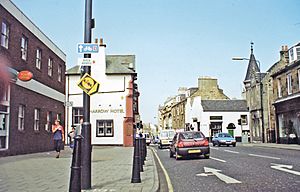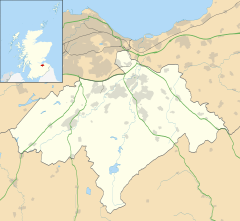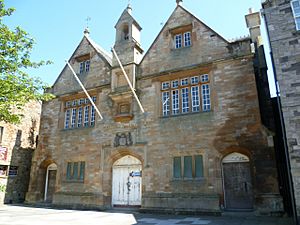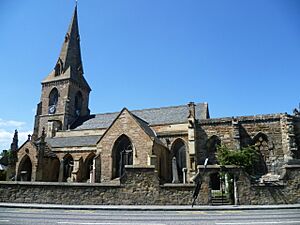Dalkeith facts for kids
Quick facts for kids Dalkeith
|
|
|---|---|
 |
|
| Population | 14,330 (2020) |
| Council area | |
| Lieutenancy area | |
| Country | Scotland |
| Sovereign state | United Kingdom |
| Post town | DALKEITH |
| Postcode district | EH22 |
| Dialling code | 0131 |
| Police | Lothian and Borders |
| Fire | Lothian and Borders |
| Ambulance | Scottish |
| EU Parliament | Scotland |
| UK Parliament |
|
| Scottish Parliament |
|
Dalkeith (pronounced dal-KEETH) is a town in Midlothian, Scotland. It sits by the River Esk. Dalkeith was given special town rights in 1401 and 1540, which helped it grow. The town started around its 12th-century castle, which is now Dalkeith Palace.
In 2011, about 12,342 people lived in Dalkeith. The town has four main parts:
- Dalkeith itself, with the town centre and old buildings.
- Eskbank, a nicer area to the west with many large old and new houses.
- Woodburn, an area to the east with many council homes and some new houses.
- Newbattle, a small village to the south with its abbey.
Dalkeith is the main office centre for Midlothian. It is also a twin town with Jarnac, France. In 2004, a court in Dalkeith was named Jarnac Court to celebrate this friendship.
On the edge of Dalkeith, at Woodburn, is the Dalkeith Campus. It opened in 2003. This campus is home to both Dalkeith High School and St David's Roman Catholic High School. It also has sports and fun facilities for the community.
Contents
What Does the Name Dalkeith Mean?
The name Dalkeith comes from an old language called Cumbric. It is thought to mean 'meadow of the wood' or 'valley of the wood'. This name describes the area well, as it has both open land and trees.
How Old is Dalkeith?
Discovering Dalkeith's Past
Archaeologists found many old things when the Dalkeith Northern Bypass was built. They learned a lot about the area's history. They found traces of two round houses and lines of pits. They also found a temporary Roman army camp.
These discoveries showed that people have lived in the Dalkeith area for a very long time. They have been there since the Stone Age. Most people lived on the sandy riverbanks. Not many lived on the harder clay ground.
A Look at Dalkeith's History
Early Records and Important Visitors
One of the first mentions of Dalkeith is in the writings of Jean Froissart. He was a famous writer who stayed at Dalkeith Castle for 15 days. He wrote about the Battle of Otterburn. He also mentioned seeing a young James Douglas, 2nd Earl of Douglas at the castle.
In 1650, Oliver Cromwell's army came to Dalkeith. His officer, General George Monck, was in charge of Scotland. The country's government was run from Dalkeith Castle at that time.
Growth and Connections
In 1831, Dalkeith got a railway link to Edinburgh. This Edinburgh and Dalkeith Railway helped transport coal, minerals, and farm goods. Later, in 1853, the Corn Exchange was built. It was the biggest indoor grain market in Scotland.
In 1879, a famous politician named William Ewart Gladstone started his campaign to become British Prime Minister in Dalkeith. This event was known as the "Midlothian campaign".
Important Buildings in Dalkeith
Churches and Historic Sites
The Collegiate Church of St Nicholas Buccleuch, also called Dalkeith Parish Church, is on High Street. It was built in the Middle Ages and became a special church in 1406. Parts of the church were changed in 1854. The old choir area is now a ruin.
James Douglas, 1st Earl of Morton, and his wife Joanna are buried here. St Nicholas Buccleuch is one of two Church of Scotland churches in Dalkeith. The other is St John's and King's Park Church.
St Mary's Church is an Episcopal Church on High Street. It is at the entrance to Dalkeith Country Park. St David's Church, on Eskbank Road, is the only Roman Catholic church in town. It is a very important old building, built in 1854.
Dalkeith Palace and Other Landmarks
Dalkeith Palace is on the north-east edge of town. It replaced the old castle in the late 1500s and was rebuilt in the early 1700s. It used to be the home of the Duke of Buccleuch. The palace is surrounded by large parkland.
Other interesting buildings include a Watch Tower at the cemetery from 1827. There is also a water tower and old iron mills from the early 1800s. The Masonic Temple on High Street was finished in 1766.
Edinburgh College has its Midlothian Campus in Eskbank. It is near the railway station. There is also a modern meeting house for Mormons on Newbattle Road.
The Midlothian Community Hospital is just outside Dalkeith. It is located near the town of Bonnyrigg.
Famous People from Dalkeith
Many notable people have connections to Dalkeith:
- Robert Aitken (1734–1802) was a Bible publisher.
- Sir John Anderson (1882–1958) was an important government official. He was a Home Secretary and Chancellor of the Exchequer.
- Beetty Dick (1693–1773) was a unique female town crier in Dalkeith.
- Henry Dundas, 1st Viscount Melville (1742–1811) was a well-known politician.
- Fish (born Derek Dick) (b. 1958) was the lead singer of the band Marillion.
- Darren Fletcher (b. 1984) is a famous footballer who played for Manchester United.
- Peter Guthrie Tait (1831–1901) was a mathematical physicist.
- James Stagg (1900–1975) was a meteorologist who helped with the D-Day landings.
Getting Around Dalkeith
Roads and Railways
Until 2008, the main road south from Edinburgh, the A68, went through Dalkeith. A new bypass was finished in 2008. This bypass now carries the A68, taking traffic away from the town centre. The old route is now the A6106.
Other important roads in Dalkeith include:
- The A6094 goes towards Bonnyrigg and Peebles to the southwest. It also goes towards Musselburgh to the northeast.
- The A768 goes west from Eskbank to Lasswade and Loanhead.
Dalkeith was reconnected to the national rail network in 2015. This happened when the northern part of the Waverley Railway Line was rebuilt. There is now a station at Eskbank on the western edge of Dalkeith.
Buses and Walking Paths
Most bus services in Dalkeith are run by Lothian Buses. East Coast Buses and Borders Buses also serve the town.
For people who enjoy walking, the Penicuik–Dalkeith Walkway passes very close to Dalkeith.
Sports in Dalkeith
Football Teams
Dalkeith is home to Dalkeith Thistle F.C.. This football club was started in 1892. They play at King's Park. The club is now part of the East of Scotland Football League.
Dalkeith Thistle also has a Community Football Club. It is based at Cowden Park, Woodburn. This club is run by volunteers and helps young players.
Rugby Teams
Dalkeith RFC is the town's rugby club. They play in the Scottish Rugby Union East Leagues. This club was the first in Midlothian to allow women to be full members. They were also the first in the area to have a women's team.
Famous players from the club include Sir David Murray. His rugby career ended after a car crash. Adam Robson, who later became President of the Scottish Rugby Union, also played for Dalkeith RFC.
Images for kids
-
Frontage of Dalkeith Palace
Twin Town
Dalkeith is twinned with Jarnac in France. This means the two towns have a special friendship.
See also
 In Spanish: Dalkeith para niños
In Spanish: Dalkeith para niños















